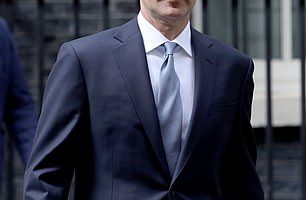THE new £50 note featuring World War II code-breaker Alan Turing has finally been given a release date – and it’s sooner then you think.
The highly anticipated bank note will be released on the scientist’s birthday – June 23, 2021.
Paper £50 notes can continue being used even after the new version has been released into circulation.
The Bank of England (BoE) hasn’t set a date for when the paper ones will be withdrawn yet, but has promised to give at least six months notice.
The new note was unveiled today by the Bank’s boss Andrew Bailey and is the last polymer bank note to be released into circulation.
Turing’s £50 note joins the Winston Churchill £5 note, Jane Austen £10 note and JMW Turner £20 note.
The plastic notes have been replacing the paper versions over the past few years as they have been designed to be more secure.
The two windows and two-colour foil make it more difficult to counterfeit, while the polymer material is waterproof and harder to rip, making them last longer.
Like the £10 and £20 notes, there is also a raised pattern punched into it so people with a vision impairment are able to identify them.
It comes weeks after the Bank teased fans with a cryptic binary code message in a nod to Turing.
Turing is best known for being the Enigma code breaker at Bletchley Park responsible for decrypting Nazi messages – shortening the war by four years.
Benedict Cumberbatch played the troubled scientist in the 2014 film, The Imitation Game.
Despite his monumental help with the national effort in WWII, he was charged over homosexual activity in 1952.
He pleaded for chemical castration by a series of injections of female hormones, which made him impotent. He was also barred from continuing his work with GCHQ.
Turing died from cyanide poisoning in an apparent suicide in 1954, and 59 years later the mathematician was granted a posthumous royal pardon in 2013.
The new note will feature a photo of him taken in 1951 by Elliott & Fry, alongside a table of a mathematical formula.
How did Alan Turing’s work help during the Second World War?
ALAN Turing was asked to join the Government Codes and Cypher School, a code-breaking organisation which is now known as GCHQ.
The organisation moved to Bletchley Park in Buckinghamshire, which became the top secret home of Britain’s code breakers.
He was based in the famous Hut 8 and his most notable achievement at Bletchley was cracking the Germans’ ‘Enigma’ code.
The Enigma was a machine used by the German armed forces to send encrypted messages securely.
Together with fellow code-breaker Gordon Welchman, developed a machine called the Bombe which from late 1940 was decoding all messages sent by the Enigma machines.
Turing’s team also cracked complex German naval signals in 1941, contributing to Allied victory in the Battle of the Atlantic.
His other work included developing a machine to encode and decode voice communications.
Underneath the picture of Mr Turing is a quote from him, saying: “This is only a foretaste of what is to come, and only the shadow of what is going to be.”
Mr Bailey said: “There’s something of the character of a nation in its money, and were right to consider and celebrate the people on out banknotes….
“By placing him [Turing] on our new polymer £50 banknote, we are celebrating his achievements, and the values he symbolises.”
Director of GCHQ Jeremy Fleming said the note is a “landmark moment” in history.
He said: “Turing was embraced for his brilliance and persecuted for being
gay.
“His legacy is a reminder of the value of embracing all aspects of diversity, but also the work we still need to do to become truly inclusive.”
The Bank had received 227,299 nominations from members of the public during a six-week nomination period which closed in December.
This led to a list of 989 eligible names of people who are real, dead and have contributed to science in the UK.
Nineteenth century mathematician Ada Lovelace, eighteenth century engineer Charles Babbage, and physicist Stephen Hawking were among those shortlisted.
This post first appeared on thesun.co.uk














